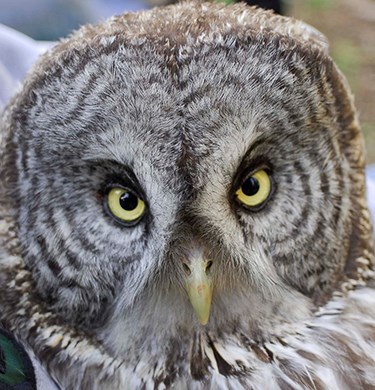
Joe Medley / U.S. Forest Service 
Joe Medley Great gray owl research provides evidence that the Sierra Nevada is home to a genetically distinct population, compared to great gray owls outside of California. Scientists, in 2010, documented Yosemite's great gray owl (Strix nebulosa Yosemitensis) as genetically distinct from the great gray owl in western North America (Strix nebulosa nebulosa). In addition to genetic differences, behavioral differences appear to exist in the Yosemite subspecies. These include differences in migration patterns, prey preference, and nest site selection. Each of these genetic and behavioral characteristics indicates the Sierra Nevada population of great gray owls has been isolated from other populations for an extensive period of time. Yosemite, today, is the southernmost range and last sanctuary of almost all of California's great gray owls, listed as California State Endangered Species. Researchers estimate there are only about 200 to 300 individuals in California, and about 65% of the state's population resides in Yosemite. Great gray owls nest in the middle elevations of the park where forests and meadows meet. They can be active at any time of the day or night, preferring to hunt in open meadows and clearings within the forest.Then, in winter, they move downslope to snow-free areas where they can more easily access their rodent prey. This rare and endangered owl is the largest North American owl but also can be found in Asia and Europe. It stands as tall as 2 feet with a 5-foot wingspan and has distinctive piercing yellow eyes accented by large facial disks. To gain a greater understanding of Yosemite's great gray owl and its genetic make-up, Yosemite joined with the U.S. Forest Service's Pacific Southwest Research Station and geneticists from University of California-Davis to assess genetics, ecological-limiting factors, and immediate management needs of the Sierra-wide population. Great gray owls, restricted to montane meadows, are threatened from mounting resource use in the broader Sierra Nevada. Threats outside the park include timber harvest, grazing, and development pressures. 
Joe Medley National parks like Yosemite that provide nearly intact ecosystems are critically important to both identify new species of plants and animals and to provide a laboratory in which to conduct scientific study. Yosemite's research aims to develop a predictive GIS-based habitat model of great gray owl distribution and habitat associations; and design a long-term monitoring plan to assess population trends. Future genetic research on the great gray owl in Yosemite would help develop a technique to identify individual owls from their molted feathers. This non-invasive research method would allow scientists to study survival rates, reproduction patterns, and other important information through the DNA found in the collected feathers. Additionally, this research method would mitigate negative impacts on the sensitive great gray owl population in the park. More Information
ReferencesResearch on the gray gray owl conducted from 2004 to 2010 is summarized in Conservation and Management of the Great Gray Owl 2007-2009: Assessment of Multiple Stressors and Ecological Limiting Factors report [1.6 MB PDF]. Read work by Pacific Southwest Research Station's John J. Keane and University of California-Davis' Holly B. Ernest and Joshua M. Hull in the 2010 citation naming the Strix nebulosa Yosemitensis:
|
Last updated: November 17, 2025
